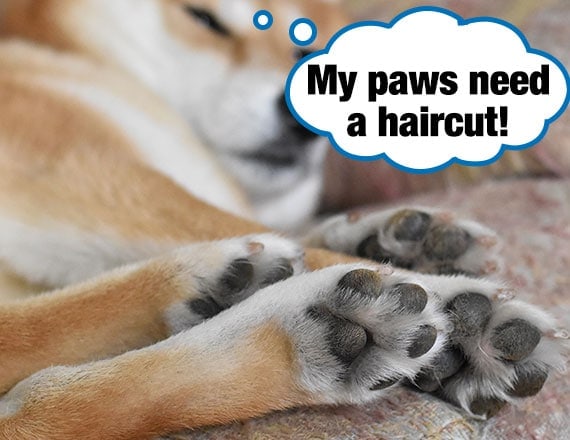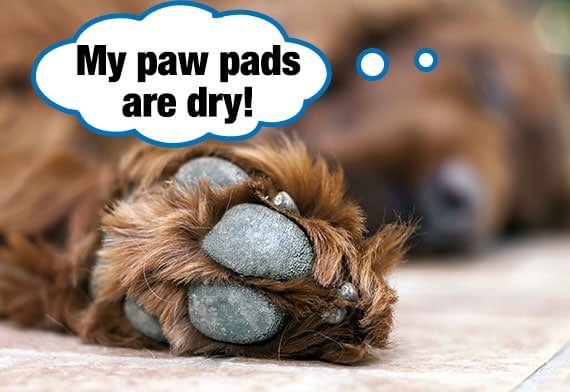Give your pup’s feet a trim for better grip

A quick haircut could be all that is needed for improved traction on hard floors.
You see, your dog has hairy feet. Not just on top, but underneath too. If you lift your dog’s paw, you’ll see fur between his paw pads. As this hair grows longer, it can cover the paw pads.
When your pup takes a step, he is stepping on this long fur, causing him to slip and tumble. It’s like trying to run in a pair of furry slippers. Not recommended by the way.
That long paw pad hair has to go. It’s time to groom your dog’s furry feet.
A shaver will deal with the long hair that falls over the top of the toenails. But to trim the fur that grows between the paw pads, many owners find it more precise to use a pair of pet grooming scissors…
Don’t feel comfortable trimming your dog’s foot hair? Reach out to your local dog groomer – they will have your pup groomed in no time!
With your pup’s long hair gone, there is nothing to come between his paw pads and the floor.
Keeping your dog safe while in the home takes just a little effort but can go a long way toward improving your dogs independence and confidence. The easier you can make life for your dog the easier life will be on you.
Cohesive Bandage Cohesive bandage (e.g., VetWrap) is something every pet parent should have in their home. Its an essential part of a first aid kit for any pet (or human). Also, it can be a terrific traction aid! Its inexpensive and it comes in a variety of colors and patterns for even the most discerning fashionista. See the video below on how to use cohesive bandage for traction as well as to reduce slight scraping of the nails.
Since these booties were not originally intended as traction aids for long-term, indoor wear, and since the neck of the bootie can be a little snug, we have made some slight modifications to the design and application so that the booties can be applied easily and be worn for up to several days at a time. All you need is the Pawz Dog boots some Elastikon elastic tape, and a scissors. See video below.
There are many indoor traction and safety options for dogs. What solutions might work best for you and your dog? Lets take a look at these options:
Trimming Nails One thing is certain – short nails improve traction and long nails reduce traction because they can cause a dog to slip (unless youre using nail cap grippers on your dog where a slightly longer nail is helpful). If you hear your dogs nails “clicking” on the ground as they walk across the tile or wood floor, chances are their nails are too long. If their nails are too long, their paw pads have less contact with the floor. Paw pad skin is slightly abrasive and provides good traction. When nails are too long, less pad skin is in contact with the ground and therefore, the dog has less traction. Proper nail trimming and maintenance are so important for a dogs wellbeing that theres even a Facebook Group with close to 150,000 members dedicated to the subject of nail maintenance in dogs! Electric nail trimmers have come a long way! We recommend an electric Dremel sander, (which I use with my own dogs and it still works great after 10 years!). Now, Dremel makes a pet-specific version and there are other electric nail sanders specifically made for pets of all sizes. Nail trims do not have to be stressful. To desensitize your dog, run the nail trimmer while petting your dog or giving them a treat until they get used to the “buzzing” sound. When your dog is desensitized to the sound, you can start filing the nails. Firmly hold one nail in between your thumb and index finger and lightly brush the nail trimmer against your dogs nail. Holding your dogs nail will help to absorb the nail trimmers vibration. Pick one nail to file down and do so for just for a few seconds. Even if your dog seems comfortable with the trimming process, jump to another nail. Do not stay on the same nail for too long; this will distract the dog and also reduce the chance of the nail getting too hot from the trimmer. You can always go back and continue trimming the nail after youve done a few others. The idea is to rotate from nail to nail, smoothly and quickly. Start with only 2-5 nails as tolerated per session. End on a positive note. You can revisit nail trimming later in the day or even the next day. Theres no huge rush to get all the nails trimmed in one sitting; after all, your dog lives with you.
Fix those cracks (in your pup’s paws)

Your dog already has built-in traction control. I’m talking about his paw pads.
However, these paw pads can also be the cause for your dog’s legs sliding out from underneath him…
You know the tires on your car? As they wear down or get damaged, they don’t grip the road properly.
Well, your pups paw pads work in the same way. If they are dry, cracked or worn down, they can’t grip your floor.
A quick spot check will determine whether your dog’s paw pads are the cause.
One of the most popular ways to fix damaged paw pads is paw balm. Think of it as moisturizer designed for your pup’s paw pads.
Application couldn’t be more straightforward. Rub the paw balm over the paw pads, massaging it in with your fingers. If you have a dog who hates you touching his paws, a
It is worth mentioning that cracked paw pads can be caused by allergies, nutritional problems and other medical conditions. When in doubt, consult your vet.[1]
How To Stop Your Dog From Slipping On Floors? Know Top 10 Easy Tricks
Many older dogs, for a variety of reasons, have less control of their rear legs than when they were younger. This loss of control creates significant issues for their mobility, especially on slick floor surfaces. One of the most common reasons to have to make end-of-life decisions for medium to large breed dogs is the loss of mobility. Managing the floor surface for them can make a big difference in how well and how long your elderly dog can keep getting around on their own.
Slick surfaces make it far too easy for dogs that have nerve dysfunction of any sort to slip and fall while walking. Slick surfaces also make it difficult to impossible for those same dogs or those suffering from arthritis to get the traction they need to push up to stand from sitting or lying down.